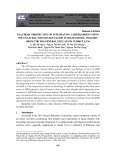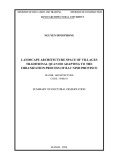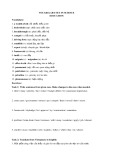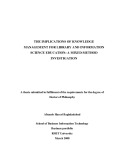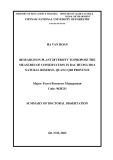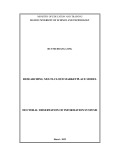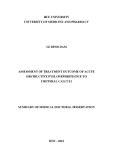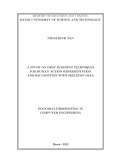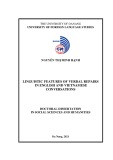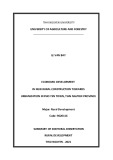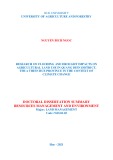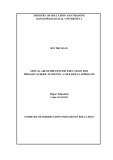MINISTRY OF EDUCATION AND TRAINING HANOI NATIONAL UNIVERSITY OF EDUCATION
HOANG VAN TAI
TRAINING AND DEVELOPING ALGORITHMIC THINKING FOR
STUDENTS IN TECHNICAL UNIVERSITIES THROUGH THE
COURSE OF DESCRIPTIVE GEOMETRY
Major: THEORY & METHODOLOGY OF MATHEMATIC EDUCATION
Code: 62 14 01 11
THE SUMMARY OF DOCTORAL DISSERTATION
IN SCIENCE EDUCATION
HA NOI – 2016
The work was completed at:
Department of Mathematics - Hanoi National University of Education
Scientific supervior: Prof. Bui Van Nghi. PhD
Reviewer 1: Assoc. Prof. Trinh Thanh Hai. PhD Thai Nguyen University of Sciences Reviewer 2: Assoc. Prof. Nguyen Xuan Thao. PhD
Hanoi University of Science and Technology
Reviewer 3: Assoc. Prof. Nguyen Anh Tuan. PhD Hanoi National University of Education
The dissertation will be defended before the Council of dissertation assessment
or at: Hanoi National University of Education
At: ............. on ……/……/ 2016
The dissertation can be further referred at:
- National Library of Vietnam
- Library of Hanoi National University of Education
PREAMBLE
1. Reason of study
+ Improvement of learner’s capability: Conference of UNESCO in 2003
presented a report which analyzed clearly significant changes on the need and
demand of knowledge society for students, especially capability of problem
solution and innovation of thought.
+ Role of Descriptive geometry in Technical universities: Helping learners to
present and read drawings, and build up the cooperation and creativity in career.
+ Practical teaching of descriptive geometry shows that: Although this
course is very essential for the profession, its results of teaching and studying are
not high. One of the reasons is the method of teaching and studying, of which
students do not grasp the algorithm in each solution. If an appropriate method is
applied, this weakness will be improved to foster the effectiveness of teaching and
studying.
+ Development of thinking for students: To understand and solve problems
on descriptive geometry, students are not only good at spatial imagination but also
be able to solve problems in a logical and accurate manner and well apply
procedures, basic mathematical problems and other rules of basic procedures and
problems. In addition, students are encougared to propose the alternative ways to
solve mathematical problems by different procedures. All those things create a type
of thought, called Algorithmic Thinking. It is not only necessary for the course of
descriptive geometry but also for the life.
+ Regarding to the relevant researches: There are several researches on the
development of innovative thinking, logical thinking, algorithmic thinking... for
students, but they do not mention about training and developing algorithmic
thinking for students of technical universities.
For the above mentioned reasons, the chosen subject is “Training and
developing algorithmic thinking for students of technical universities though the
course of descriptive geometry”
2. Scientific theory
According to the theoretical and practical base on development of
algorithmic thinking for learners, if during the course of descriptive geometry,
trainers equip students the basic algorithm and create opportunities for them to
propose algorithm as well as improve gradually the level of algorithmic
application, students shall have better learning outcomes and develop their
algorithmic thinking.
3. Goal and mission of study
+ Goal: Proposing methods of training and developing algorithmic thinking
for students of technical universities through the course of descriptive geometry,in order
to help students with better learning results and development of algorithmic thinking.
+ Mission of study: To gain the above goals, the missions include:
(1) Brief introduction on thinking; algorithmic thinking and its role, through
published scientific documents.
(2) Practical investigation on the studying of descriptive geometry and
development of algorithmic thinking for students of technical universities.
(3) Proposing methods of training and developing algorithmic thinking for
students of technical universities through the course of descriptive geometry,in
order to help students with better learning results and development of algorithmic
thinking.
(4) Implementation of pedagogical experiment to evaluate the posibility and
effectiveness of the study
4. Research method
Main methods applied in this thesis are:
+ Theoretical studies (performing tasks (1), (3));
+ Survey and Observation (performing tasks (2), (4));
+ Pedagogical experiment (performing tasks (4);
5. Objects and scope of study
- Object of study is a process of teaching descriptive geometry, training and
developing algorithmic thinking for students of technical universities
- Scope of study: Content, teaching program of the descriptive geometry
course in the technical universities
6. New contribution of the study
+ For theoretical Perspectives
- Generalize the domestic and abroad researches and systematize theoretical
perspectives on algorithm, algorithmic thinking and development of algorithmic
thinking in teaching mathematics.
- Actual situations on training and developing algorithmic thinking for students in
teaching and learning the course of descriptive geometry in technical universities.
- Propose possible and effective solutions for training and developing
algorithmic thinking for students in teaching and learning the course of descriptive
geometry in technical universities
+ For pracical perspectives
- Study results contribute to the innovation and improvement of teaching
and learning quality of descriptive geometry in technical universities
- It is a useful reference document for colleagues and students in technical
universities
7. Defended issues
(1) There are domestic and aboard researches on algorithm, algorithmic
thinking and development of algorithmic thinking in teaching Mathematics,
Informatics, Computer Science, however the issues of training and developing
algorithmic thinking for students in technical universities during the course of
descriptive geometry has not been studied yet.
(2) There are some shortcomings on teaching and learning descriptive
geometry in technical universities that affect the teaching effectiveness and quality
of this course.
(3) Mesures to train and develop the algorithmic thinking for students in
technical universities during the course of descriptive geometry proposed in this
research are possible and effective.
8. Study structure
Besides preamble and conculsion, this thesis consits of 03 chapters.
Chapter 1: Theoretical and practical base
Chapter 2: Measures to train and develop algorithmic thinking for students in
teaching Descriptive geometry
Chapter 3: Pedagogical experiment
Chapter 1
THEORETICAL AND PRACTICAL BASE
1.1. Brief of study
1.1.1. Abroad researches on algorithm and algorithmic thinking
1.1.1.1. For algorithm and teaching algorithm
* Research on the appearance of “algorithm”, Morten Misfeldt (2015)
indicated that: The appearance of the algorithm is associated with the birth of
Mathematics. Evgeniy Semakin Khenner and Igor (2014) stated: The algorithm
describes the sequence of actions (plan), which are performed strictly according to
the instructions to solve the problems in a finite number of steps. According to
Robert J. Sternberg (2000), in daily life, we have learned some algorithms and
ocassionally created it to guide others to do something.
* Research on teaching algorithm, Evgeniy Semakin Khenner and Igor
(2014) stated: The algorithmic teaching has also appeared very early, in the form of
puzzle or fun maths. The book of Levitin Anany (2008) presented many algorithms
and exercises with programming puzzles and algorithms. The book of Thomas H
Cormen (2009) introduced the algorithm 3E, which is used at many universities
worldwide. Marasaeli, Jacob perrenet, Wim M.G. zwaneveld jochems and Bert
(2011) has proposed four abstract levels in the algorithmic thinking of students
corresponding to those of algorithm as follows: (1) Implementation level; (2)
Program level; (3) Object level; and (4) Problem level.
1.1.1.2. For algorithmic thinking
Studies of algorithmic thinking in a foreign country are consistent with the
concept of algorithm in Informatics. According COMAP (Consortium for
Mathematics and Its Applications) (1997): "Algorithmic thinking" is one kind of a
mathematical thinking. The expression of algorithmic thinking is: Application of
algorithm; Development of algorithm; Analysis of algorithm; Noting the problem
without algorithmic solution. According to Gerald and Julia Moschitz Futschek
(2011), algorithmic thinking is an important capability in Informatics that can be
separated with the learning of computer programming.
1.1.2. Domestic researches
1.1.2.1. For algorithm and teaching algorithm
In essence, each calculation, rules for calculation and solving the equations
... are algorithm. In Geometry, there are some algorithms such as: drawing with a
ruler and compass. At university, algorithms are also found, for example:
calculating the definite, higer equatations, matrix inversion and determinant…
Nguyen Ba Kim and Vu Duong Thuy (1992) defined the algorithm as followings:
“The algorithm is considered as a descriptive rule of the clearly accurate
instructions helps people (or machines) to perform a series of actions with the aim
of achieving its propsed goals or solving a certain problem. It is not an exact
definition but merely a statement which helps us to imagine the concept of
algorithm intuitively”. Bùi Văn Nghị (1996) used the definition on algorithm of the
two above authors and added the concept “algorithmic procedure”. Vương Dương
Minh (1996) studied “Development of algorithmic thinking for students while
teaching numeration system in high schools". The author has given a definition of
algorithm as follows: "Algorithm is an accurate and simple rule of limited numbers
of primary actions following a definite order specified on the object so that we will
obtain desired results after perporming that procedure”. Some authors also
identified the two concepts, "algorithm" and "algorithm" such as works of Chu
Cẩm Thơ (2015), Nguyễn Chí Trung (2015)
1.1.2.2. For algorithmic thinking and development of algorithmic thinking
There are domestic researches on development of algorithmic thinking for
students. For instance, a research of Vũ Quốc Chung (1995) on fostering capacities
of thinking for students in the final grade of primary school; a work of Nguyễn
Thái Hòe (1997) on training the thinking for students via mathematic exercises;
works of Nguyễn Đình Hùng (1996), Nguyễn Văn Thuận (2004) on developing
logical thinking for students; awork of Tôn Thân (1995), Trần Luận (1996) on
fostering creative thinking for students.
Among the domestic researches on algorithm and algorithmic thinking, it
can be counted for Trần Thúc Trình (1975), Nguyễn Bá Kim (1992, 2011, 2015),
Vương Dương Minh (1996) và Bùi Văn Nghị (1996).
Nguyen Ba Kim (2011) suggested that algorithmic thinking is shown in the
following activities: (i) Implementing the activities following the certain order in
accordance with a provided algorithm; (ii) Anlalyzing an activity based on
performance of its components in a certain order; (iii) Describing exactly the
process of conducting an activity; (iv) Generalizing an activity on a group of
objects from an activity; (v) Comparing different methods to perform the same
work in order to find the optimal solution.
Based on the research results on algorithm and algorithmic thinking, the
conclusion is summarized as follows:
- The domestic and abroad authors agree with the concept of algorithm in
Computer Science and Informatics. However, the researchers in mathematics
education in domestic schools only concern about the concept of algorithm in
intuitive manner. Meanwhile, researchers in Computer Science and Informatics can
not stop at this limit, especially when they need to prove the non-existence of an
algorithm to solve a problem; an algorithm based on the Turing machine or
recursive function are required.
- It is nesscessary to distinguish algorithm in science from algorithm in daily
life. If a solution process does not consit of specific and clear actions to gain a good
result, it only is considered an algorithmic-like process
- Many abroad authors assumed “algorithmic thinking” in the meaning of
strict in Computer Science and Informatics; some domestic authors considered
algorithmic thinking as an algorithmic-like process.
1.2. Concepts on algorithm and algorithmic thinking in this thesis
1.2.1. Algorithmic concepts
In this thesis, we assume: The algorithm is considered as a descriptive rule of
the clearly accurate instructions helps people (or machines) to perform a series of
actions with the aim of achieving its propsed goals or solving a certain problem.
1.2.2. Algorithmic thinking concepts
We assume that: Thinking is a cogitative way to perceive things,
phenomena, and the natural and social relationships and human that is expressed
through notion, judgments, and inference. These concepts do not concentrate on the
psychological nature of the cognitive process, but appearance (more intuitive) on the
thinking. Algorithmic thinking is applied to solve problems through not only algorithm
but also “algorithmic process" or “algorithmic-like process".
1.3. Descriptive geometry course in technical universities
1.3.1. Brief history of descriptive geometry
Descriptive geometry was introduced by Gaspard Monge (1746-1818) and
used in French education system since Century XVIII. In Vietnam, since the year
60s of the previous century, when the first universities was established, descriptive
geometry was taught officially in Univerity of Technology and Science.
1.3.2. Brief introduction of descriptive geometry
Descriptive geometry is the branch of geometry which allows the
representation of three-dimensional objects in two dimensions by using a specific
set of procedures. This course equips the leaners knowledge and skills to
understand and draw the technical drawings. Knowledge of descriptive geometry is
basic, compulsory and minimum for a student in technical universities.
In descriptive geometry, each point A in the space is represented by only a
pair of projection (A1, A2) on two planes of perpendicular projection. And vice
versa, each pair of projection (A1, A2) on two planes of perpendicular projetions
identifies point A in space. Thus the representation of spatial projection on two
planes of perpendicular projections shall totally define the size and shape of
geometrical figures. All problems of descriptive geometry are problems of the
formatting image; every problem has only one answer. Hence, application of
algorithm to solve the problems of descriptive geometry can be considered.
1.3.3. The expression , the level of algorithmic thinking of students and
the opportunity to develop algorithmic thinking in teaching descriptive
geometry at the Technical University of block
1.3.3.1. The expression, the level of algorithmic thinking of students
expressed through descriptive geometry module
Thinking algorithm University students Technical block manifested in
descriptive geometry module through the ascending levels of the following:
i) To comply with the basic algorithm known in the course of payment;
ii) Imagine , performing the entire process of solving the problem, solve the
problem according to the block diagram, process simulation or language, or
algorithms written into the program;
iii) Know how to apply these algorithms known during problem solving;
iv) May participate in the proposal, design algorithms in the process of
accounting;
v) Can select the optimal algorithm in multiple algorithms and solve a
problem.
1.3.3.2. Opportunities to develop algorithmic thinking in teaching
descriptive geometry at the Technical University of block
- Opportunities for the content knowledge in module
- Chance of cognitive abilities of students
- Opportunity to organize teaching methods
1.4. Practical Situation of teaching and learning descriptive geometry in
technical universities
1.4.1. Advantages and disadvantages of students in learning descriptive
geometry
* Advantage: Basic knowledge of descriptive geometry is based on basic
knowledge of Euclidean geometry which was taught in high schools. Some
drawing softwares such as AutoCad, Cabri, GSP… can be used in teaching and
learning descriptive geometry
* Disadvantage: When studying the descriptive geometry, the learners are
required to have spatial imagination and logically reasoning ability.
1.4.2. Investigating practical situation of teaching and learning descriptive
geometry in technical universities
We have designed and used Questionnaire on teaching and learning the descriptive geometry for 250 2nd year students - term 57 and 58 at two educational
institutions of the University of Mining and Geology (Hanoi and Vung Tau) in
September (one month after learning the course of descriptive geometry) in 2013
and 2014.
Results show that: When start learning the descriptive geometry, most of
students (80%) reported that this is a difficult subject, the rest 20% stated that this
subject is very difficult. Many reasons were reported by students as follows. For
10% of students, the reason is students must understand thoroughly the knowlgde
in high schools; 25% assumed that they has not found a proper learning methods, in
which 15% for teacher’s teaching methods and 10% for timing isues; for 40%
thought that it is difficult because of requirement of good spatial imagination.
Therefore, most of students are not interested in this subject; 20% feel normal and
only 15% are excited with that.
In conclusion, it is propably stated that the descriptive geometry is quite
abstract and difficult for students in technical, civil engineering and architectural
universities. Also teachers has not concerned appropriately about formity and
development of algorithmic process for students, leading to low effectiveness of
teaching
1.5. Conclusion of Chapter 1
In the technical universities, descriptive geometry equips students the basic
knowledge to understand and draw technical drawings, also contributes to develop
spatial imagination, algorithmic thinking, creative thinking for students, engineers,
architects, industrial art painter during their work. Therefore, teaching the course of
descriptive geometry in the direction of training and development of algorthmic
thinking for students of technical universities are justified.
Chapter 2
MEASURES TO TRAIN AND DEVELOP ALGORITHMIC THINKING FOR
STUDENTS IN TEACHING DISCRIPTIVE GEOMETRY
2.1. Measures building orientation
(1) Orders of measures should be suitable to procedures of forming and
developing algorithmic thinking for students
(2) Measures proposed should be suitable to students and perception
process of leaners.
(3) Measures should be feasible and effective
(4) Measures aim to innovate the present methods of teaching discriptive
geometry
2.2. Basic definitions and knowledge in descriptive geometry
2.3. Methods to train and develop algorithmic thinking for students in
teaching descriptive geometry
2.3.1. Method 1: select some basic algorithmics and train stydents to well
apply them into basic maths in Descriptive geometry.
2.3.1.1. Method base: base on the learners; base on the difficulty of
descriptive geometry course; base on the content of descriptive geometry.
2.3.1.2. Method implementation approach
First and foremost, we need to select some basic algorithmics.Those are
procedures that problems in Descriptive Geometry will be inferred to. If students
are trained to be skillfull in those basic Algorithmics, there are more chances for
them to solve simple descriptive geometry problems.
We selected the following basic algorithmics:
- Determine a point on a line;
- Determine the intersection point of a common line and the projected planes
(trace of line);
- Determine the vertical projected plane (projected by) (P) contains a given
line a (a1, a2);
- Determine the true magnitude of a line segment;
- Define a line perpendicular to the plane.
Specifically,
Basic algorithmics 1: Determine a point on a line
In descriptive geometry, there are some common problems as follows:
determine the intersection point of two intersected lines, determine a point of a
given triangle or a given tetrahedron, and identify a point in a generatrix of a
cylindrical or conical surface. These problems are all defined as determining a
point on a line. Hence, we decided that the algorithmics to determine a point of a
straight line is a basic algorithmics.
Situation 1: line d is a normal line (not perpendicular to the axis x,
algorithmics to identify A in d as follows:
Step 1: Identify A1 d1
Step 2: Identify A2 d2 so that A1A2 x
Situation 2: line d is a special line (which is perpendicular to axis x, also
called an edge line) – determined by two points B (B1, B2) and C (C1, C2),
algorithmics identifies point A on line d as follows
Step 1: determine A1 B1C1
Step 2: determine A2 B1C2 so that A1A2 x, single ratio of a three-point set
B1,C1,A1 equals to , single ratio of a three-point set B2,C2,A2: (B1C1, A1) =
is a single ratio of a three-point set B, C, A on a (B2C2,A2). Therein (BC,A) =
straight line.
From this basic algorithmics, we can infer the following algorithmics to
solve basic problems:
Problem 1.1. Determine a point on plane (ABC): given point M on plane
(ABC) = (A1B1C1, A2B2C2). Determine the projection
by M2 when vertical projection M1 is known (Figure 1)
Algorithms for solving the problem as follows:
Step 1: Determine I1 = B1C1 ∩ A1M1;
Step 2: Apply basic algorithm 1 to identify I2;
Step 3: Apply basic algorithm 1 to identify M2;
(If B1C1//A1M1, we identify I1 = B1C1 ∩ A1M1
and follow the same procedure)
Figure 1
Problem 1.2. Determine a point on a plane of
tetrahedron ABCD.
Problem 1.3. Given a quadrilateral ABCD (P) = (V1P, V2P), known
vertical projection A1B1C1D1, determine projection by A2B2C2D2.
Projection 1.4. Given a plane (ABC), make line b of the plane with given height
x
Problem 1.5. Determine a point on a cone of revolution
Algorithmics 2: determine intersection point of a line and projected planes.
Given line a (a1, a2), determine intersection point M of
a and (P1) and intersection point N of a and (P2).
Algorithmic steps to solve the problem as follows:
If a straight line is not parallel to the plane of
projection, the procedure for determining trace a
following
Figure 2
Step 1: Determine M2 = a2 ∩ x;
Step 2: Apply basic algorithm 1 to identify M1;
Step 3: Determine N1 = a1 ∩ x;
Step 4: Apply basic algorithm 1 to identify N2.
If a is frontal (a2 // x), the intersection N of a and (P2) is identified by B1 and
B2 above; If a is surface (a1 // x), the intersection M of a and (P1) is identified by
B3 and B4 above
Use the basic algorithmics 2, we can solve the basic problems on finding
traces of a plain.
Problem 1.6. Given (P) determined by 2 intersected lines a (a1,a2), b (b1,b2),
a and b do not parellel to axis x. Find traces of plane (P).
Problem 1.7 Determine the intersection of the vertical projection plane (P)=
(V1P,V2P) with plane (Q) = (a//b)
Problem 1.8 Determine the intersection of the vertical projection plane (P)=
(V1P,V2P) with plane (Q) = (V1Q,V2Q).
Basic algorithmics 3: Determine the vertical projection plane (projection
by) containing a given line
Basic algorithmics 4: indentify the real magnitude of a segment
Basic algorithmics 5: identify a line perpendicular to a plane
Problem 1.9. Identify distance from point A (A1, A2) to plane (P) in
following cases: (P) = (V1P, V2P);b) (P) = (a x b)
Problem 1.10. Identify distance from A to line d
2.3.2. Method 2: Train the students to use some mehods to demonstrate
algorithmics in teaching descriptive geometry.
2.3.2.1. Method base: base on the significance of the block diagram; base on
teaching method of algorithmics.
2.3.2.2. How to implement the method
+ When teaching Descriptive Geometry, teachers need to combine analysis
to solve problems with algorithmic demonstration. This combination will clarify
the analysis and the students also can learn about algorithmic demonstration.
Lecturers can select some cases and activities for modeling, and then ask students
to practice some similar cases.
Example 2.3.1: when teaching about second basic algorithmics, besides this oral
description, we can demonstrate algorithmics by simulation language as follows:
Beginning:
If a1 // x
Then a a ∩ P2 = ϕ, a ∩ P1 = M, with M2 = x ∩ a2, M1M2 x;
x And if a1
Then consider a2
If a2//x
then a ∩ P1 = ϕ, a ∩ P2 = N so N1 = x ∩ a1, N1N2 x
x
if a2
then a ∩ P1 = M so M2 = x ∩ a2, N1= a1 x, M1M2 x, N1N2 x
ending.
Schematic illustration (Figure 3):
Figure 3
+ Instruct students to practice some similar examples
Example 2.3.2. Demonstrate algorithmics by block diagram to identify the
line perpendicular to plane
Schematic illustraction: (Figure 4)
(a) (b) (c)
Figure 4
2.3.3. Method 3: create opportunites for students to joind hands in
building and propose some algorithmics in solving some problems in descriptive
geometry
2.3.3.1. Method bases: Base on process of training and develop algorithmic
thinking mentioned in orientation 1 in chapter 2; base on plate-tectonic theory and
operational perspective; base on the needs of developing capacity of leaners; base
on memory effectiveness; base on course contents;
2.3.3.2. How to implement the method
(1) Select the problems demonstrates many cases and give chance for
leaners to cooperate, discuss, propose algorithmic solution for each case.
Example 3: Relative position of two distinguished lines, 3 situations:
Situation 1: two normal lines;
Situation 2: one normal line and one special line
Situation 3: two special lines: with two normal lines, 3 possibilities for two
projections of the same name: intersected by two, parallel by two, an intersected
pair and a parallel pair. When two projection pairs of the same name intersect by
two: whether two intersection points lie on the same alignment line.
The same possibility happens for the rest of situations.
Hence, a discussion among students can be organized: what is the relative
position of each following schemetic? (Figure 5)
Figure 5
2.3.4. Method 4: Apply different algorithmics in descriptive geometry and
practical application
2.3.4.1. Method base
+ Base on objectives of the descriptive geometry course of technical
universities;
+ Base on the orientation of developing capacity for learners;
2.3.4.2. How to implement the method
First approach: train the students to identify the intersection of two surfaces
in line with 3 level of increasing difficulty: interface of 02 polyhedrons; interface of
01 polyhedron and 01 curved surface; interface of 02 curved surfaces; intersection
of 03 surfaces
We need to combine several times of following algorithmics:
- Algorithmics to identify intersection of two planes;
- Algorithmics to identify the intersection point of line and plane;
Moreover, we need to use auxiliary planes and identify intersection points of
both planes on each auxiliary plane. The problem now is to identify the intersection
of lines on the auxiliary plane. For example: find the intersection of of two
cylindrical surfaces: let (R) parallel to generatrix of two cylinders; find intersection
of two conical surfaces: let (R) go through conical peak and parallel to the
generatrix of the cylindrical surface; find the intersection of two conical surfaces:
let (R) contain line connecting two peaks of both cones….
Example 4: Identify the intersection between an oblique prism with base
∆DEF and a cone S.ABC in the schematic in Figure 6a
a b
Figure 6
Possible steps to identify the intersection of these two faces:
- Identify the auxiliary cross section of vertical projection , δ,… to find the
intersection of sides d, e, f of the prism and the cone, we have peaks 1, 2, 3, 4.
- Identify the auxiliary cross section of vertical projection by ,… to find the
intersection of sides of cone with prism, we have peaks 5, 6. The result is the
schematic as in figure 6b.
* For the intersection of two curved surfaces: we can devide students into
groups for researching of each following pairs:
(1) Identify intersection of 2 conical faces which share the same base;
(2) Identify intersection of a conical face with peak S and a cylindrical face
which share the same base;
(3) Identify intersection of two conical faces which do not share the same
base;;
(4) Identify the intersection of two cylindrical faces share the same base;
(5) Identify the intersection of a conical face and a spherical face;
(6) Identify intersection of a cylindrical face and a spherical face.
Second approach: Combination between Descriptive Geometry and
Technical drawing.
Technical Drawing Module is considered a direct application of the
knowledge of Descriptive Geometry. In Technical Drawing, students must reach
the following requirements: from a drawing, students have to imagazine and
present the objects on the axonometric view. Descriptive geometry will help us
overcome the difficulties in visualizing the object and know the intersection of the
two surfaces in the space from given drawings. Therefore, during Descriptive
geometry, teachers need to train students to be familiar with the drawings and
understand the design idea of the drawing.
Example 5. Given 03 objects as Figure 8. Identify the intersection of surfaces?
Present those intersections on multiview drawing.
Figure 8
Third approach: Assign each group of students to perform the assignments:
Researching an architectal work or creating an architectual form based on the
intersection of 02 surfaces.
Example 6. Design "pluripotent" bottle cap which can cover three types of
bottles as follows: A round cap with diameter of a; A square cap with a side of a; A
isosceles triangle cap with the bottom side of a and its height of a. (Figure 9)
Figure 9
The needed cap should be the common part of three circular cylinders with
vertical sections respectively in shape of the three above mentioned bottles. The
problem will be determined to identify the intersection of three cylinder surfaces
(three surfaces of these three cylinders).
2.4. Conclusion of Chapter 2
Our solution is to focus on training algorithms in soving the problems of
descriptive geomestry for students. This solution has helped students to learn this
course more efficiently and develop their algorithmic thinking. We asume that the
initial actions should be noted to form, train amd develop gradually algorithmic
thinking for students. Firstly, students need to become familiar with the basic
algorithm (foundation, core) and practice to master that through basic problems
(Method 1); training them some forms of algorithmic represetation (Method 2);
Then they can propose their own algorithims in a simple way (Method 3). Finally,
the measure to help them to combine and apply many algorithms effectively
(Method 4).
Chapter 3
PEDAGOGICAL EXPERIMENT
3.1. Pedagogical experiment purposes, methods and organization
3.1.1. Purposes of pedagogical experiment
Pedagogical experiment aims at assessing the feasibility and effectiveness
of measures in training and developing algorithmic thinking for technology
students through the module of Descriptive Geometry proposed in the thesis.
3.1.2. Pedagogical experiment methods and organization
Pedagogical experiment is conducted in two phases, with 2 units per phase:
Phase 1: Unit 1 to be taught from September 9 to 14, 2013, Unit 1 from
September 23 to 28, 2013, at the Hanoi campus of University of Mining and
Geology. The class chosen for pedagogical experiment was K58 Oil Refinery
(with 60 students), taught by Lecturer Hoang Van Tai, in 2 curriculums presented
in Section 3.2 of the thesis; whilst the control class was K58 Engineering Geology
(with 60 students) taught by Lecturer Le Thi Thanh Hang, in self-written
curriculum. Unit 1 –“Determining traces of a plane" practice (tasks on position
estimates, including 2 periods); Unit 2 - "Distance" practice (tasks on trigonometry
including 2 periods).
Phase 2: Unit 1 to be taught from September 8 to 13, 2013, Unit 1 from
September 22 to 27, 2013, at the Vung Tau campus of University of Mining and
Geology. The class chosen for pedagogical experiment was K59 Drilling and
Production (with 53 students), taught by Lecturer Hoang Van Tai, in 2 curriculums
presented in Section 3.2 of the thesis; whilst the control class was K59 Mining
Geodesy (with 51 students) taught by Lecturer Vu Huu Tuyen, in self-written
curriculum. The 2 units were identical as in Phase 1. The lecturers of pedagogical
experiment classes and control classes teach the same subject, of approximately the
same age, seniority and pedagogic capacity (as identified by the Department)
3.1.3. Pedagogical experiment preparation
Step 1: Preparing lesson plans and questionnaire for observers and students
on experimental lessons
Step 2: Department discussion, aiming to an agreement on experiemental
teaching purpose, organization, content, method and result assessment, and on the
test (questions, pedagogical goals, scale and answer key);
Step 3: Conducting experimental lessons, collecting comments of observers
and students through the questionnaire.
Step 4: 45-minute test after each lesson for the experimental class and
control class occured at the same time, with the same questions and answer keys
Step 5: Pedagogical experiment results processing
3.1.4. Pedagogical experiment hypothesis
Students would have a better understanding of the topics, distributing to the
development of their algorithmic thinking if taught to the curriculum based on
training methods for algorithmic thinking development as proprosed in Chapter II
of the thesis.
3.2. Pedagogical experiment content
(Experimental lesson plans attached in the thesis)
3.3. Pedagogical experiment result assessment
+ Qualitative Assessment: by questionnaires done by 226 students
participating in the lessons and 20 observers
+ Quantitative Assessment: by two tests after each experimental lesson:
classifying, creating table charts, bar charts and statistical hypothesis testing.
For instance, the comparation of post-experimental result of the 1st test of the 1st phase between the experimental class and the control class is demonstrated in
the chart below:
Chart 1. Comparation of the 1st test result
3.4. Summary of Chapter III
Pedagogical experiment was conducted in two phases, each one of them took
place at the campus of University of Mining and Geology (in Hanoi and Vung
Tau), with two classes taught by pedagogical experiment and two control classes.
Pedagogical experiment results are assessed by tests with participation of
240 students (both times) and 20 observers. Despite the fact that the pedagogical
experiment was conducted in a small scale, the results have shown that:
- The feasibility and effectiveness of pedagogical experiment plans were
reassured;
- Dual goals obtained in experimental lessons: The students having a better
understanding of lesson contents and contributing to the development of their
algorithmic thinking.
CONCLUSIONS AND RECOMMENDATIONS
CONCLUSION
The thesis has the following results:
(1). Briefly introduce domestic and abroad research results on teaching
algorithm and development of algorithmic thinking for learners;
(2). Present the sientific base of development of algorithmic thinking for
students in technical universities through teaching the descriptive geometry:
Conception of algorithm, algorithmic thinking, demand and means for development
of algorithmic thinking for learners.
(3) Propose 04 methods to train and develop the algorithmic thinking based
on required procedures and goals of the descriptive geometry course for students in
technical universities.
(4) Carry out the pedagogical experiment at two educational facilities of
University of Mining and Geology (Hanoi and Vung Tau).
REQUEST
Oriented curriculum development , capacity -oriented learners, so it takes
time for students to apply what they have learned into practice career , solve
problems arising from the practice . Thus the increase in the length module ,
increasing the time and enhance the practice of occupational activity is an
important issue and needed. Opinion, should have at least 4 credits of this module
can be reduced by difficulties in teaching and learning modules for both teachers
and students.
PUBLISHED WORKS OF THE AUTHOR RELATING
TO THE THESIS
1. Hoang Van Tai – Vu Huu Tuyen (2012), Designing situations of teaching
the procedure defined the poit projection via “Trigonometry problem” in
Desriptive Geometry, Journal of Education Science, ISN 0868 – 3662, No. 84,
page 28 – 30.
2. Hoang Van Tai (2014), Development of algorithmic thinking for students
through teaching Descriptive Geometry, Journal of Science, ISN 0868 – 3719,
Volume 59, page 121 – 128.
3. Hoang Van Tai – Nguyen Thi Huong Lan (2015), Algorithmic thinking in
problems defined the trace of plane (Descriptive Geometry), Journal of Science,
ISN 2354 – 0753, Special edition in 10/2015, page 123 – 125.
4. Hoang Van Tai – Nguyen Thi Huong Lan (2015), Cooperative teaching
“Defining the intersection line of 02 quadric planes” in Descriptive Geometry at
University of Mining and Geology, Journal of Education, ISN 2354 – 0753, Special
edition in 10/2015, page 126 – 128.
5. Hoang Van Tai (2016), Algorithm development thinking for students of
technical universities through block modules descriptive geometry, Journal of
Education Science, ISN 0868 – 3662, Special edition in 01/2016, page 45 – 47.
6. Hoang Van Tai (2016), Algorithm development thinking and problem-
solving capacity for students in teaching descriptive geometry, Journal of Science,
ISN 2354 – 0753, No. 377, page 47 – 49.



